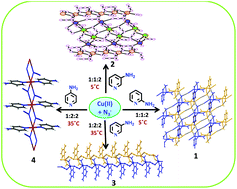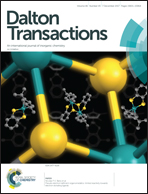Ligand directed structural diversity and magnetism in copper(ii)–azido assemblies with isomeric aminopyridines: synthesis, structure, magnetism and theoretical studies†
Abstract
Four new copper complexes, viz. [{Cu(2-aminopyridine)(N3)2(H2O)}2]n (1), [Cu3(3-aminopyridine)2(N3)6]n (2), [{Cu(3-aminopyridine)(N3)2}2]n (3), and [Cu(4-aminopyridine)2(N3)2]n (4), have been synthesized with isomeric aminopyridines, viz. 2-aminopyridine (2-ap), 3-aminopyridine (3-ap), and 4-aminopyridine (4-ap), to probe the role of ligand and reactant molar ratios in directing the polynuclear assemblage and the associated magnetic properties. Ligand geometry is quite influential as can be seen through the versatile structures formed, viz. a hydrogen bonded layer of μ-1,1 azide bridged Cu dimers in 1; a network of two different types of dimers (Cu1–Cu2 & Cu3–Cu3′) involving μ-1,1; μ-1,3; μ-1,1,3; & μ-1,1,3,3 azide bridges in 2; a ladder structure in which μ-1,1 azide bridges form the rungs and μ-1,3 azide bridges form the rails of the ladder in 3; and a 1-D polymer chain involving μ-1,1 azide bridges in 4. Consistent with the bridge geometry, compounds 1 & 2 display ferromagnetic interactions, while 3 & 4 display antiferromagnetic interactions. The rather unexpected antiferromagnetic interactions in 3, in spite of μ-1,1 azide bridged rungs may be due to the crossover near the bridge angle. The ferromagnetic interactions in 1 and 2 are supported by DFT calculations.



 Please wait while we load your content...
Please wait while we load your content...